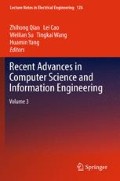Introduction
Satellites have become an important role in man’s daily life since the first satellite launched in 1957. Their by- products - space debris, resulting from spent rocket stages and defunct satellites to explosion and collision fragments increase greatly in recent years, whose amount have reached 16,000 now according to data published by US NORAD. The space debris can be tracked and cataloged by space surveillance facilities, such as radars or telescopes.
Access this chapter
Tax calculation will be finalised at checkout
Purchases are for personal use only
Preview
Unable to display preview. Download preview PDF.
References
NASA, Obital Debris Quater News, 14, 2 (April 2010)
Hoots, F.R., Crawford, L.L., Roehrich, R.L.: An analytic method to determine future close approaches between satellites. Celestial Mechanics and Dynamical Astronomy 33 (1984)
Foster, J.L., Estes, H.S.: A Parametric Analysis of Orbital Debris Collision Probability and Maneuver Rate for Space Vehicles, NASA/JSC-25898 (1992)
Bai, X., Chen, L.: A Fast Algorithm of Space Debris Collision Possibilities Based on Space Compression and Infinite Series. Acta Mathematicae Applicatae Sinica 32(2), 336–353 (2009) (in Chinese)
Kenneth Chan, F.: Spacecraft Collision Probability, ch.6. The Aerospace Corporation (2007)
Author information
Authors and Affiliations
Corresponding author
Editor information
Editors and Affiliations
Rights and permissions
Copyright information
© 2012 Springer-Verlag GmbH Berlin Heidelberg
About this chapter
Cite this chapter
Shen, M., Gao, P., Guo, X., Yang, D., Yu, H., Zhao, Y. (2012). Space Debris Collision Risk Assessment on HPC System. In: Qian, Z., Cao, L., Su, W., Wang, T., Yang, H. (eds) Recent Advances in Computer Science and Information Engineering. Lecture Notes in Electrical Engineering, vol 126. Springer, Berlin, Heidelberg. https://doi.org/10.1007/978-3-642-25766-7_43
Download citation
DOI: https://doi.org/10.1007/978-3-642-25766-7_43
Published:
Publisher Name: Springer, Berlin, Heidelberg
Print ISBN: 978-3-642-25765-0
Online ISBN: 978-3-642-25766-7
eBook Packages: EngineeringEngineering (R0)

